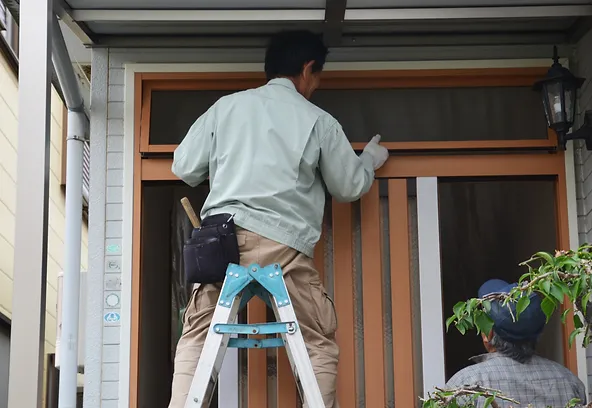
If you want to paint your house right, attention to detail is a must. From selecting the right colors to preparing the surfaces, each step is critical in the painting process. When the goal is achieving a beautiful and long-lasting finish, there’s no aspect too small to matter for the overall effect. One crucial element that can go unnoticed but is important for the professional finish: the quality of caulk used during the painting process. A bad caulk job has a really large negative impact, but it doesn’t have to stay that way. Explore below how to fix a bad caulk job and how to caulk in preparation for painting. Understand whether it’s better to paint or caulk first with this guide from the experts here at Liberty Painting.
What is Caulk?
Before we dive into the potential pitfalls of a bad caulk job, let’s first understand what caulk is and its purpose in painting. Caulk is a flexible material that is used to seal gaps and cracks around areas where two different materials meet, including windows, doors, and baseboards. It is typically applied before painting to ensure a smooth and even surface. Caulk helps prevent air and moisture infiltration, enhances the appearance of the finished paint job, and provides protection against mold and mildew.

The Importance of Quality Caulk
Using high-quality caulk is crucial for several reasons. First, it provides a durable seal to prevent air and water from penetrating your home. This is especially relevant with exterior painting, as maintaining the integrity of your walls prevents damage caused by moisture intrusion. Also, quality caulk adheres well to different surfaces. This ensures long-term performance, which in turn reduces the need for frequent touch-ups or repairs. Importantly, high-quality caulk is less likely to crack or shrink over time, which can lead to unsightly gaps and compromised sealant properties. So when you’re looking into how to caulk for painting, you have to first be able to identify quality caulk so you can avoid a bad caulk job.
Signs of Low-Quality Caulk
Clearly, using good caulk is the way to go. But how can you tell? Here are some signs that can help you recognize when you have low-quality caulk on your hands:
1. Difficulty in Application
Caulk quality can typically be determined by the application difficulty. Smooth application is going to be affected by whether you paint or caulk first, but either way, inferior caulk tends to be clumpy or stringy, making it challenging to achieve a clean finish. This low-quality caulk may also have a strong odor, further diminishing the user experience. So if it’s hard to apply, you’re likely dealing with a lower-quality caulk.
2. Lack of Adhesion
Similarly, poor adhesion is another telltale sign of low-quality caulk. If the caulk does not stick well to the surface, it may start to peel or crack shortly after application. Damage like this will both compromise aesthetic appearance and undermine the seal’s efficacy. This type of bad caulk job won’t last long.
3. Premature Cracking or Shrinking
Low-quality caulk often dries out too quickly, leading to premature cracking or shrinking. This can result in gaps and openings that allow air and water infiltration, defeating the purpose of caulking in the first place.
4. Limited Lifespan
Inferior caulk typically has a shorter lifespan compared to higher-quality alternatives. It may degrade faster under exposure to sunlight, temperature fluctuations, or moisture, necessitating frequent reapplication or repairs. Here at Liberty Painting, with our high-quality caulk, we offer a 2-year happiness guarantee. A bad caulk job means you only get a short-term solution.
5. Lack of Flexibility
Flexibility is a crucial characteristic of good caulk, as it allows for natural expansion and contraction of building materials. Low-quality caulk tends to be rigid and brittle. You will notice a resistance, where this caulk is unable to withstand movement without cracking or breaking. A lack of flexibility is one of the most obvious ways to determine a bad caulk job.
6. Unsightly Appearance
Low-quality caulk often warps the appearance of your paint job. The bumps or ridges that come from an uneven textured caulk drying are difficult to completely cover with paint. You want your walls and trim to have the best appearance, so this aspect is important. No matter whether you choose to paint or caulk first, a low-quality caulk can show through and affect the overall end result in appearance and longevity.
FAQs about Low-Quality Caulk and Paint Jobs
Let’s address some frequently asked questions regarding the impact of low-quality caulk on paint jobs:
Can I use any type of caulk?
While there are different types of caulk available, not all are suitable for painting. Choose a paintable caulk specifically designed for use in your type of project. Using the wrong caulk can result in a bad caulk job with adhesion issues, an uneven finish, or paint peeling. Our team will be happy to help you determine the type of caulk needed in a project you do with us.
Can I save money by using low-quality caulk?
Low-quality caulk may seem like a cost-effective option initially, but it often leads to additional expenses in the long run. The need for frequent touch-ups, repairs, or even a complete redo of the paint job can far outweigh any savings from using inferior caulk.
How can I identify high-quality caulk?
Finding high-quality caulk can seem intimidating, but there are resources to help. Look for caulk products that are labeled as paintable and suitable for your specific application. Reading reviews and seeking recommendations from professionals can also help you identify reputable brands known for producing high-quality caulk. Take a look at some examples of high-quality caulking in our gallery.
Can I apply caulk over existing low-quality caulk?
There are cases where it may be possible to apply new caulk over existing low-quality caulk. But this only works when that old caulk is clean, dry, and in good condition. Removing the old caulk and starting with a clean slate instead is often the best approach for achieving optimal results.
Is there a specific technique for applying caulk?
Yes! And this technique isn’t just traditional; proper caulk application is essential for a successful paint job. Start by cleaning the surface thoroughly, then cut the caulk tube tip at a 45-degree angle and apply a steady bead of caulk in one continuous motion. Use a caulk smoothing tool or a wet finger to create a smooth finish and remove any excess caulk. You can get help from our experts to get your happiness guaranteed with the smooth finish of your caulking.
Can I get help with caulk selection?
Absolutely! Our professional painters at Liberty Painting have extensive experience in helping you determine the right materials, including caulk, for individualized projects. Our team will assess your specific needs, recommend high-quality caulk products, and ensure a flawless paint job.
Should I paint or caulk first?
While it does depend on the nature of the project, typically, caulking first is the better choice. Caulking first closes up holes for a smoother painting process. When you caulk first, this ensures that caulking lines can be hidden by the paint. However, for some projects, caulking can be done afterward. For example, a ceiling can be painted, then caulked, if the molding or trim will hide the caulk lines. Our experts will help you determine whether you should paint or caulk first with your project.
How can I fix a bad caulk job?
If you’re wondering how to fix a bad caulk job, the answer is: experts know best. As discussed earlier, you can sometimes apply fresh caulk over the top of a bad caulk job. However, it’s usually best to scrape the old caulk away and then start from scratch. Often, the process is essentially the same as how you would caulk for painting with an extra step: getting rid of the remnants of the old job first. Our team can give you more specific advice for your home’s situation.

Conclusion
Choosing the right caulk for your painting project is paramount to achieving a beautiful and long-lasting finish. Low-quality caulk can not only lead to a bad caulk job, but also a terrible paint job, with issues such as poor adhesion, premature cracking, and unsightly appearances. By investing in high-quality caulk, you ensure a durable seal, excellent adhesion, and a professional-looking result. Of course, it’s important to recognize the technical process of how to caulk for painting, but that won’t do you much good if you don’t start with a quality product. So, remember, when it comes to caulk, quality matters.
Contact the experts at Liberty Painting and never experience a bad caulk job again. We can help you with your small home repairs and painting projects from start to finish. Book your consultation today!







Leave A Comment